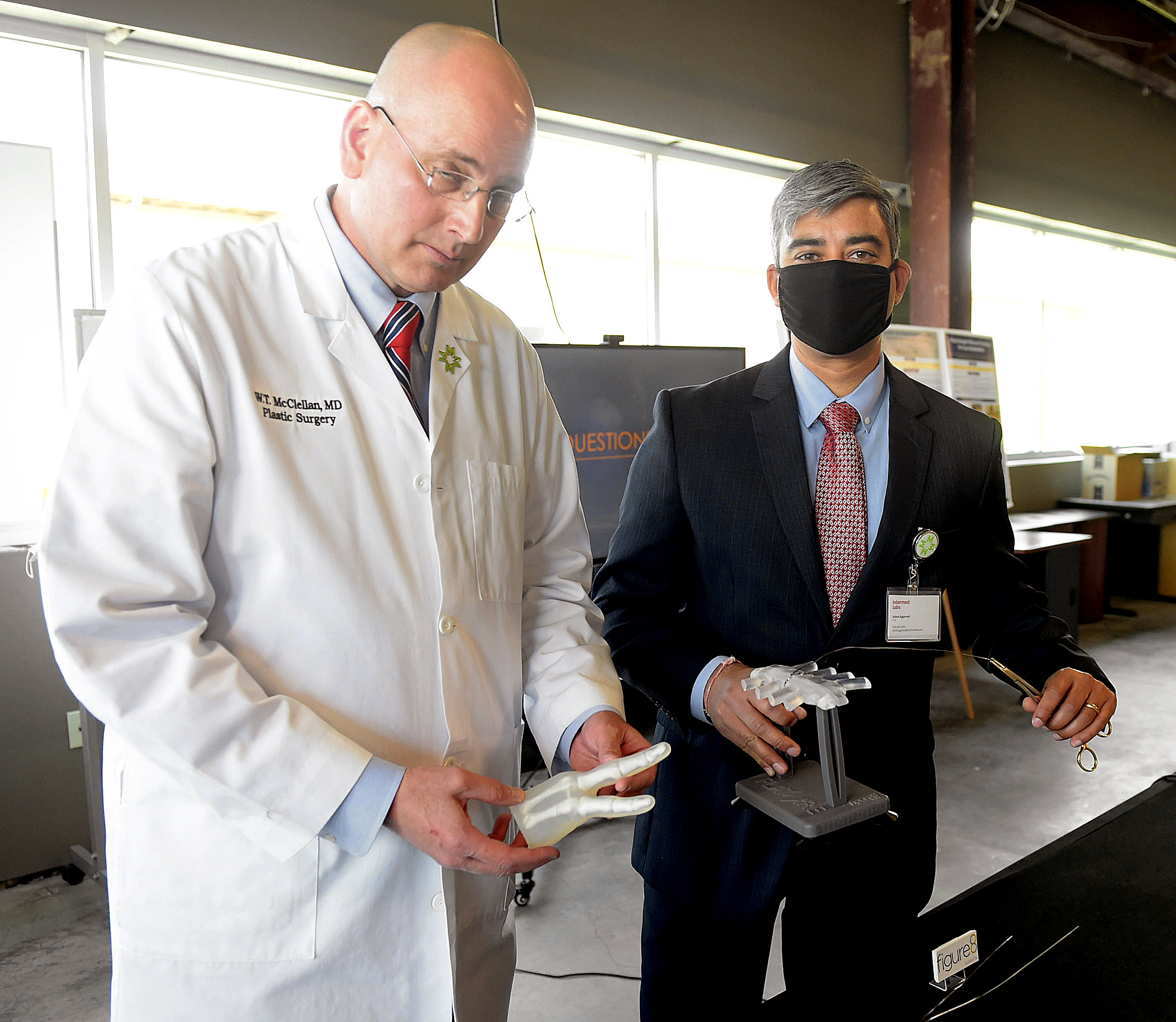MORGANTOWN – It’s a bare bones room on the top floor of the upper building of the Mon Health medical park – really bare bones: concrete floor, fluorescent lights dangling down below exposed steel beams.
Arrayed on tables were things called Fingy, ScarChargr, Octopus, H4ND3D (or HandEd), MoodZZZ and Figure 8 FlatWire.
Legislators, business leaders and others assembled there Monday to goggle at the hardware and learn the story of the company behind them: Intermed Labs at Mon Health, housed in this space still undergoing development into an office.
Intermed is a MedTech – medical technology – startup studio. It’s not a business incubator, which supports new companies, or an accelerator that scales up existing companies, said founder and CEO Dr. Thomas McClellan, a Mon Health plastic and reconstructive surgeon.
Intermed exists at the very beginning of MedTech development. They go up into the hospital, talk to doctors, nurses and techs about their problems and their ideas to address them. “We’re at the base level R&D. We’re builders.” They help the creators traverse the path from idea to marketable product.
“We’re very quick, six months,” McClellan said. “Either this idea’s going to work or we’re moving on.” Each product that pans out will become a standalone company. “We surround an idea with everything that’s needed.”
They analyze, design, engineer, seed fund for up to $50,000, build prototypes, provide intellectual property protect, test the product, publish it and present it to corporations that might want to acquire it. They’re vertically integrated with money backing through Mountain State Capital and a medical device angel fund. The team includes physicians, engineers, marketing specialists and WVU student interns, among others.
Intermed formed a public-private partnership with Mon Health last October and in December joined the Global Startup Studio Network, an exclusive group of venture building studios. Intermed is the only studio in Appalachia and the GSSN membership connects it to innovators from studios in California, Dubai and Paris.

Mon Health President and CEO David Goldberg told the assembled guests how the hospital got involved. McClellan contacted him one day, he said, and told him about this opportunity for clinicians to develop ideas to advance technology, help patients and build up West Virginia, and to own a piece of their product.
It didn’t take long to convince him, Goldberg said. “I don’t think it was what, a minute?” Goldberg told the Mon Health System board, and they signed on. “We put the money up and we got out of the way. … It wasn’t about no, it was about how fast we could help.”
Intermed co-founder Ashok Aggarwal gave a short history of the company. He’d known McClellan and co-founder Justin Chambers, an engineer, for years. Both had a history of bringing new MedTech to market. “To go through the process of figuring out how to take a back-of-the-napkin medical innovation and idea and bring it to the market is just an absolutely daunting and complex task, but they’ve been able to figure out over many years.
Last March, as COVID began its rampage, he approached them about any advances in respirator technology they might have in mind. That led to a ventilator splitter developed at Mon Health.
“We’re West Virginians,” Aggarwal said. “We’re patriotic people. We live in a state where we expect to do things ourselves and be somewhat independent. Ain’t nobody gonna come save us so we better find a way to save ourselves and our people.”
It also led to the idea of Intermed, Aggarwal said: helping other medical innovators bring their ideas to life.
Secretary of State Mac Warner said West Virginia has a wealth of bright medical people: 4,757 active physicians, 2,500 medical students and physician residents, 3,500 advanced degree nurses, and more than 25,000 registered nurses. “To build a diverse, strong economy it takes entrepreneurs being able to get their ideas to market. … Today they can come right here. We need the facilities to do that and Intermed Labs is doing that right here in Morgantown.”
So, just what are some of those objects we named at the beginning of this story? All were created here in West Virginia, several of them already on the market.
Fingy was just announced on Monday. It’s a low-cost splint – either firm or flexible depending on need, for people who’ve lost a fingertip. It’s only $50. “This is a major advancement,” McClellan said. “It doesn’t cost an arm and a leg; anyone can afford it.
And when someone buys one, they give one for free to another person who can’t afford it. It was designed in Morgantown but is 3D printed in Idaho, where a company has a more advanced printer. That company packages and ships it.
ScarChargr is a patented scar dressing favored by Hollywood folk – he couldn’t name any because there are no endorsement agreements. Octopus, still in development, is an innovative splint to support and protect the rib cage for people with broken ribs; among its benefits, it could keep people from developing pneumonia and going into the hospital.
McClellan developed H4ND3D. It’s a model of a portion of a human hand to allow orthopedic medical residents to learn surgical techniques before operating on real hands. The next step will be to extend it to the whole hand and wrist.
MoodZZZ is a concept originated by a Charleston psychiatrist to help her patients with bipolar disorder. It can track their sleep and activity patterns objectively with wearable technology and identify triggers for mood changes to help improve their health, wellness, and productivity.
Figure 8 FlatWire is on the market. It is a sturdier steel wire developed to replace simple steel wire for primary sternal closure following open heart surgery, to reduce the risk of the sternum splitting back open, which can cause serious complications.

TWEET David Beard @dbeardtdp EMAIL dbeard@dominionpost.com




